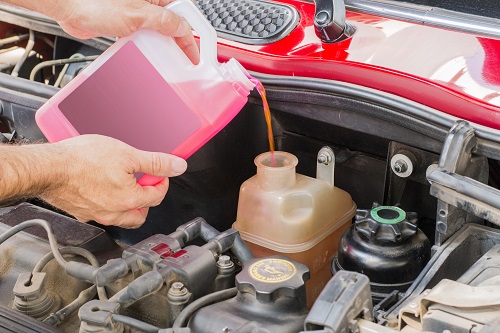
Engine coolant, often overlooked by drivers, holds more importance than meets the eye. It’s not just another checkbox on the “check fluids” list during an oil change. In fact, this unassuming liquid plays a vital role in three crucial tasks: lowering the freezing point of the cooling system in winter, raising the boiling point of the system in summer, and safeguarding the engine and cooling system against rust and corrosion throughout the year. Neglecting the proper coolant for your car can lead to costly problems down the road.
Understanding the Significance of Choosing the Right Engine Coolant
In the past, engine cooling systems were relatively simple, comprising brass, rubber, and cast iron components. Consequently, coolants were fairly standardized. However, with the advent of modern automobiles, cooling systems now incorporate various materials such as copper, silicon, nylon, steel, and magnesium-aluminum alloys. As a result, the type of coolant required by your vehicle can vary based on factors like the year, make, model, engine specifications, and even country of origin. With such complexity, it is crucial for car owners to be well-informed about the appropriate coolant for their specific vehicle.
Exploring the Different Types of Engine Coolant
To properly maintain a vehicle’s cooling system and protect the engine from harm, modern automobiles often require enhanced engine coolants. Today, automotive service providers rely on three engine coolant types:
Inorganic Additive Technology (IAT):
Known for its distinctive green color, IAT coolant was once commonly used to safeguard cooling systems. However, it is rarely utilized as factory fill in modern cars due to its fast depletion rate of additives. IAT coolant typically requires more frequent changes, usually every two years or 24,000 miles.
Organic Acid Technology (OAT):
OAT coolants are commonly specified for vehicles made certain automakers such as General Motors. They come in shades of purple, red, yellow, and orange. Typically, they are changed every five years or 50,000 miles.
Hybrid Organic Acid Technology (HOAT):
HOAT coolants offer the benefits the the other two types of coolants provide. They are primarily available in yellow and orange hues and are commonly used in Chrysler and Ford vehicles. The recommended change interval for HOAT coolants is usually every five years or 50,000 miles, although certain automakers specify longer intervals, such as 10 years or 150,000 miles.
 Hybrid and Electric Vehicle Cooling Systems:
Hybrid and Electric Vehicle Cooling Systems:
Hybrid and electric vehicles often feature a separate cooling system for the battery pack. It is essential to use coolants that meet the automakers’ specifications for these specialized systems.
In addition to these basic coolant types, each automaker may have unique requirements. It is crucial to ensure that the coolant used meets the applicable specifications, which can be found in your owner’s manual. A reliable service technician will always ensure that the coolant used meets the factory’s requirements.
Essential Points to Keep in Mind
Consider these key points when it comes to selecting your engine coolant. Color alone cannot accurately identify the coolant type. OAT and HOAT coolants often share similar orange or yellow colors, making misidentification a possibility.
Automakers do not adopt new coolants on a fixed schedule. It is entirely possible for two vehicles from the same manufacturer to require different coolant types. Just because a vehicle left the factory with a specific coolant type doesn’t guarantee that a different coolant wasn’t later installed. If transitioning back to the manufacturer-recommended coolant, you must perform a complete cooling system flush.
To ensure you make the right coolant choice and keep your vehicle running smoothly, entrusting your vehicle maintenance to a reputable auto shop in Knoxville TN is a wise move. Their expertise and knowledge will ensure that the correct coolant is selected and that your cooling system receives the care it deserves.
By relying on professionals who understand the intricacies of engine coolant and its compatibility with your specific vehicle, you can know that your car’s engine and cooling system are in good hands. Regular auto maintenance and the use of the appropriate coolant will help prevent overheating, corrosion, and other potential issues that can arise from using the wrong coolant or neglecting proper maintenance.
Don’t underestimate the significance of engine coolant in preserving the health and longevity of your vehicle. Take the time to educate yourself about the specific coolant requirements for your car, consult your owner’s manual, and seek professional guidance when needed. With the proper coolant and diligent car maintenance, you can keep your engine cool, protect your investment, and enjoy a smooth and worry-free driving experience.
The next time you come across that “check fluids” reminder, remember the critical role of engine coolant and make sure you have the right coolant to keep your vehicle running at its best. Your car will thank you, and you’ll enjoy the peace of mind that comes with knowing you’ve taken the necessary steps to care for your trusted transportation companion.
Call Miller Brothers Transmission Auto Repair and Body Shop now if you need help in dealing with your car’s engine problems.
Like our Facebook page for more great info about auto services.
Miller Brothers Transmission Auto Repair and Body Shop
7123 Tazewell Pike
Corryton, TN 37721
(865) 689-5072
https://www.millerbrosautorepair.com/
Serving Knoxville, TN and Knox County
Service areas include: All of Knox County, Corryton, Fountain City, Halls Crossroads, Powell and Knoxville

No comments:
Post a Comment